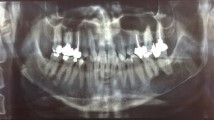Abstract
Purpose
Stylohyoid complex is anatomical structure predisposed to numerous individual variations. These may result in its extreme elongation, medial deviation and finally Eagle’s syndrome occurrence. The aim of this study was to measure the length, angulation, evaluate morphological variations of stylohyoid complex by computed tomography and, subsequently, relate obtained data to the gender and the age of the evaluated cases.
Materials and methods
The material included CT scans of stylohyoid complexes of 282 individuals. The entire length, maximal thickness, and angulation of the stylohyoid complexes in the coronal, transverse, and sagittal planes were measured.
Results
According to their morphology, orientation and length, stylohyoid complexes were classified into six morphological types. Elongated, bent, segmented, and segmented with attached stylohyoid ligament for the lesser horns of the hyoid bone stylohyoid complex types were characterized by significantly greater length, while pseudoarticulated type was characterized by significantly lower length in relation to normal stylohyoid complex type. The elongated type was additionally significantly thicker and with significantly lower value of medial angle in transverse plain than the normal stylohyoid complex type. Elongated, bent, and segmented types were significantly more frequent in males than in females. Furthermore, the frequency of the elongated stylohyoid complex type increased, whereas normal and pseudoarticulated types decreased with age.
Conclusions
In conclusion, elongated and more medially deviated stylohyoid complexes are more frequent in males than in females. Their more frequent presence in the older age groups indirectly connects this phenomenon with the aging process.


Similar content being viewed by others
References
Al-Khateeb TH, Al Dajani TM, Al Jamal GA (2010) Mineralization of the stylohyoid ligament complex in a Jordanian sample: a clinicoradiographic study. J Oral Maxillofac Surg 68:1242–1251
Anbiaee N, Javadzadeh A (2011) Elongated styloid process: is it a pathologic condition? Indian J Dent Res 22:673–677
Başekim CC, Mutlu H, Güngör A, Silit E, Pekkafali Z, Kutlay M, Colak A, Oztürk E, Kizilkaya E (2005) Evaluation of styloid process by three-dimensional computed tomography. Eur Radiol 15:134–139
Colby CC, Del Gaudio JM (2011) Stylohyoid complex syndrome: a new diagnostic classification. Arch Otolaryngol Head Neck Surg 137:248–252
Ekici F, Tekbas G, Hamidi C, Onder H, Goya C, Cetincakmak MG, Gumus H, Uyar A, Bilici A (2013) The distribution of stylohyoid chain anatomic variations by age groups and gender: an analysis using MDCT. Eur Arch Otorhinolaryngol 270:1715–1720
Fusco DJ, Asteraki S, Spetzler RF (2012) Eagle’s syndrome: embryology, anatomy, and clinical management. Acta Neurochir (Wien) 154:1119–1126
Gözil R, Yener N, Calgüner E, Araç M, Tunç E, Bahcelioğlu M (2001) Morphological characteristics of styloid process evaluated by computerized axial tomography. Ann Anat 183:527–535
Ilgüy M, Ilgüy D, Güler N, Bayirli G (2005) Incidence of the type and calcification patterns in patients with elongated styloid process. J Int Med Res 33:96–102
Jung T, Tschernitschek H, Hippen H, Schneider B, Borchers L (2004) Elongated styloid process: when is it really elongated? Dentomaxillofac Radiol 33:119–124
Kent DT, Rath TJ, Snyderman C (2015) Conventional and 3-dimensional computerized tomography in Eagle’s syndrome, glossopharyngeal neuralgia, and asymptomatic controls. Otolaryngol Head Neck Surg 153:41–47
Kosar MI, Atalar MH, Sabancioğullari V, Tetiker H, Erdil FH, Cimen M, Otağ I (2011) Evaluation of the length and angulation of the styloid process in the patient with pre-diagnosis of Eagle syndrome. Folia Morphol (Warsz) 70:295–299
Murtagh RD, Caracciolo JT, Fernandez G (2001) CT findings associated with Eagle syndrome. AJNR Am J Neuroradiol 22:1401–1402
Nakamaru Y, Fukuda S, Miyashita S, Ohashi M (2002) Diagnosis of the elongated styloid process by three-dimensional computed tomography. Auris Nasus Larynx 29:55–57
Nayak DR, Pujary K, Aggarwal M, Punnoose SE, Chaly VA (2007) Role of three-dimensional computed tomography reconstruction in the management of elongated styloid process: a preliminary study. J Laryngol Otol 121:349–353
Onbas O, Kantarci M, Murat Karasen R, Durur I, Cinar Basekim C, Alper F, Okur A (2005) Angulation, length, and morphology of the styloid process of the temporal bone analyzed by multidetector computed tomography. Acta Radiol 46:881–886
Prasad KC, Kamath MP, Reddy KJ, Raju K, Agarwal S (2002) Elongated styloid process (Eagle’s syndrome): a clinical study. J Oral Maxillofac Surg 60:171–175
Ramadan SU, Gokharman D, Tunçbilek I, Kacar M, Koşar P, Kosar U (2007) Assessment of the stylohoid chain by 3D-CT. Surg Radiol Anat 29:583–588
Rizzatti-Barbosa CM, Ribeiro MC, Silva-Concilio LR, Di Hipolito O, Ambrosano GM (2005) Is an elongated stylohyoid process prevalent in the elderly? A radiographic study in a Brazilian population. Gerodontology 22:112–115
Scaf G, Freitas DQ, Loffredo Lde C (2003) Diagnostic reproducibility of the elongated styloid process. J Appl Oral Sci 11:120–124
Sokler K, Sandev S (2001) New classification of the styloid process length—clinical application on the biological base. Coll Antropol 25:627–632
Vadgaonkar R, Murlimanju BV, Prabhu LV, Rai R, Pai MM, Tonse M, Jiji PJ (2015) Morphological study of styloid process of the temporal bone and its clinical implications. Anat Cell Biol 48:195–200
Vieira EM, Guedes OA, Morais SD, Musis CR, Albuquerque PA, Borges ÁH (2015) Prevalence of elongated styloid process in a central brazilian population. J Clin Diagn Res 9:90–92
Yavuz H, Caylakli F, Yildirim T, Ozluoglu LN (2008) Angulation of the styloid process in Eagle’s syndrome. Eur Arch Otorhinolaryngol 265:1393–1396
Acknowledgments
Contract grant sponsor: Ministry of Science and Technological Development of Republic of Serbia; contract grant numbers: 175092 and III41017.
Author information
Authors and Affiliations
Corresponding author
Ethics declarations
Conflict of interest
The authors declare that they have no conflict of interest.
Rights and permissions
About this article
Cite this article
Petrović, S., Jovanović, I., Ugrenović, S. et al. Morphometric analysis of the stylohyoid complex. Surg Radiol Anat 39, 525–534 (2017). https://doi.org/10.1007/s00276-016-1757-z
Received:
Accepted:
Published:
Issue Date:
DOI: https://doi.org/10.1007/s00276-016-1757-z




